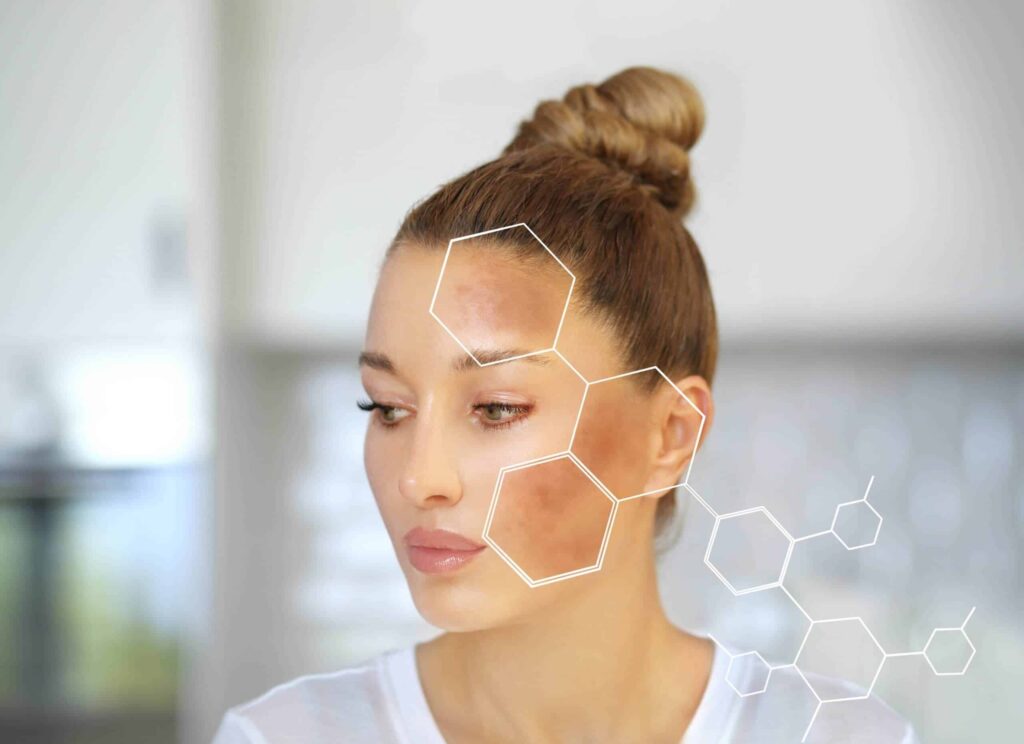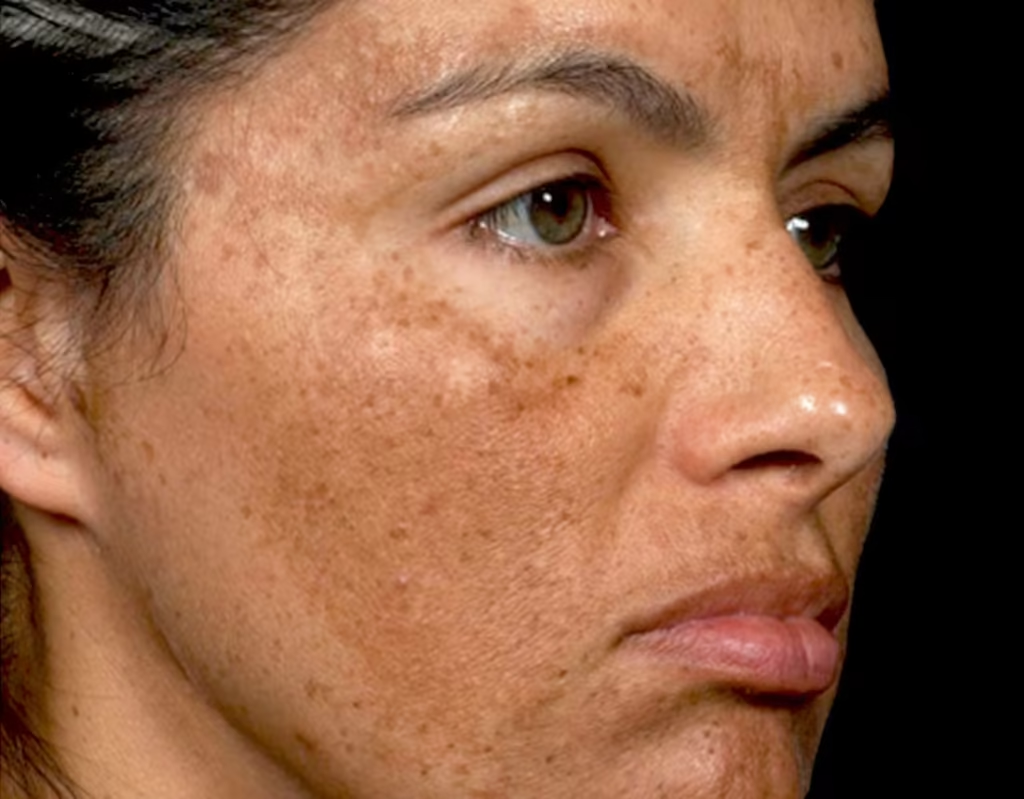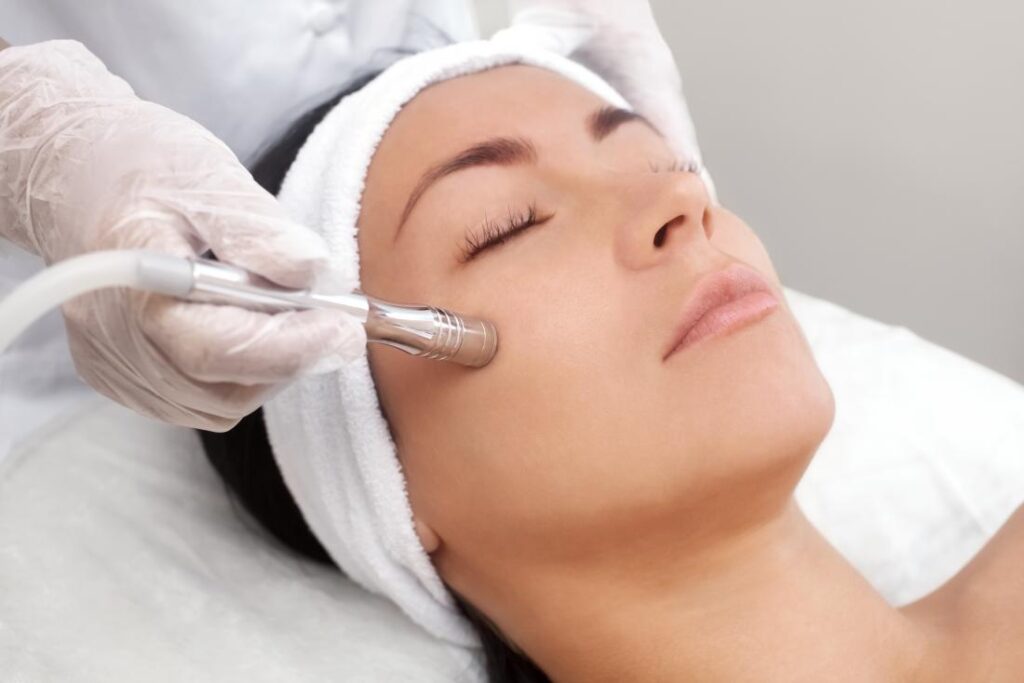Hyperpigmentation is a common skin concern affecting people of all skin types. It manifests as patches of skin that appear darker than surrounding areas when the skin produces excess melanin, the pigment responsible for skin color.
Understanding what makes your skin more susceptible to pigmentation is essential for both prevention and treatment.
Understanding Hyperpigmentation

Hyperpigmentation isn’t necessarily a condition but rather a term describing skin that appears darker than the surrounding area.
These darkened areas can occur in small patches, cover large areas, or affect the entire body. While increased pigmentation usually isn’t harmful, it can sometimes indicate an underlying medical condition.
The discoloration happens when cells that give your skin its color are triggered to overproduce pigment.
This overproduction of melanin can be influenced by various factors, from genetics to environmental exposures.
Read more: Laser Skin Pigmentation Treatment in Singapore
Types of Hyperpigmentation
There are several main types of hyperpigmentation, each with distinct characteristics:
Melasma

Also called chloasma or “the mask of pregnancy,” melasma causes large patches of darkened skin, most commonly on the forehead, face, and stomach.
It is believed to be triggered by hormonal changes and may develop during pregnancy or while taking birth control pills. It affects women more frequently, especially those with medium to darker skin tones.
Read more: Melasma Treatment in Singapore
Sunspots (Solar Lentigines)
Also called liver spots or age spots, sunspots are related to excess sun exposure over time.
They typically appear as brown, tan, or black spots on areas most exposed to the sun, like the hands, face, and other sun-exposed areas of the body. They’re more common in older adults or those with extended sun exposure.
Post-inflammatory Hyperpigmentation
This type results from injury or inflammation to the skin. It appears as spots or patches of darkened skin after an inflammatory skin condition such as acne, eczema, or following injuries like cuts, burns, or friction.
People with medium to dark skin tones may be more susceptible to experiencing post-inflammatory hyperpigmentation due to the higher amount of melanin present in their skin.
Related article: What Treatment is Best for Anti-Aging?
Risk Factors for Hyperpigmentation
Risk factors can be divided into fixed (those you cannot change) and variable (those you can control) categories.
Fixed Risk Factors
Genetics
Genetics is one of the most essential variables determining why some people are more prone to developing hyperpigmentation than others.
Melanin production is controlled by genes inherited from our parents, resulting in varying skin tones due to different types, amounts, and arrangements of melanin.
Researchers have identified more than 100 genes responsible for regulating melanin, which impacts skin color.
Genetic variations such as the MC1R gene variation are largely responsible for the development of freckles in Caucasian and Asian people when exposed to UV radiation.
You might like: The Ultimate Guide to Fractional Lasers in Singapore
Ethnicity and Skin Color
People of different ethnicities possess varying levels of melanin in their skin. Those with darker skin tones typically have greater quantities and darker types of melanin.
This protects them from sun damage such as sunburns but also makes them more susceptible to hyperpigmentation changes such as melasma and post-inflammatory hyperpigmentation.
Conversely, fair-skinned individuals who have lower and lighter types of melanin are more prone to sunburn and less prone to such hyperpigmentation changes.
Age
As we age, our skin undergoes several changes that can impact pigmentation. It’s important to distinguish between normal skin aging (which happens regardless of UV exposure) and photoaging (which occurs as a result of exposure to UV radiation).
In fact, as we age, the skin gets thinner, and we lose melanocytes, thus actually contributing to more translucent and paler skin.
However, older patients also suffer from more photoaging due to years of accumulated UV exposure, which manifests as age spots or sunspots.
Read more: A Complete Guide To Laser And Skin Treatments In Singapore
Health Conditions
Some health conditions can cause hyperpigmentation. More serious causes include Addison’s disease and hemochromatosis.
Addison’s disease affects the adrenal glands and can cause hyperpigmentation in specific areas of the body, including folds of the skin, lips, elbows, knees, knuckles, toes, and inside of the cheek.
Hemochromatosis is an inherited condition that causes the body to contain too much iron, which can make the skin appear darker or tanned.
Variable Risk Factors
Sun Exposure
Sun exposure is one of the biggest risk factors for hyperpigmentation. The body produces more melanin to protect the skin from prolonged exposure to the sun, which can cause dark spots or patches.
Ultraviolet (UV) radiation can be split into UVA-1/UVA-2, UVB, and UVC (which is completely blocked by the earth’s atmosphere).
UVA and UVB all contribute to sunburns, hyperpigmentation, photoaging, and skin cancers.
UVA rays have a higher propensity to darken the skin by penetrating the skin’s deeper layers where they stimulate melanocytes to produce melanin. UVB rays primarily affect the skin’s upper layers, causing immediate damage to the DNA within skin cells, leading to more sunburns.
More recently, visible (blue) light has also been shown to increase the risk of hyperpigmentation.
You might be interested: Fractional Laser Costs in Singapore
Hormonal Changes
Hormonal changes can significantly affect pigmentation. Common hormonal causes include fluctuations in estrogen levels, which can be affected by:
- Pregnancy: Hormonal changes, particularly increased levels of estrogen and progesterone, play a role in the development of melasma. These hormones stimulate melanocytes to produce more melanin, leading to the characteristic “mask of pregnancy” or chloasma.
- Birth Control Pills: Synthetic hormones contained in birth control pills can lead to increased melanin production.
- Menopause: Menopause marks a significant hormonal transition for women as estrogen levels decline. Some may experience improvements in hyperpigmentation conditions such as melasma, while others may experience worsening, especially in regions not on the face.
- Other Hormones: Stress hormones and thyroid hormones can also contribute to hyperpigmentation through complicated mechanisms.
This might help: Which Dermatologist in Singapore Should You Consider? (Sort by Reviews)
Inflammation and Skin Trauma
Inflammation is often signaled by redness, heat, pain, and swelling at the affected area. This is the body’s natural defense mechanism against injuries or infections.
Common causes of skin inflammation include acne, psoriasis, eczema, trauma, and infections.
During inflammation, inflammatory mediators are released, which—apart from fighting the insult—also contribute to increased melanin production by the melanocytes in the skin.
In mild reactions, these effects are focused more on the surface of the skin and can improve relatively easily.
However, in more serious or prolonged inflammation, there can be damage to the basement membrane of the epidermis.
This causes the melanin produced to leak into the deeper layers of the skin where they are consumed by white blood cells.
These can last in the skin for years and may require more intensive treatment such as lasers, microneedling, or stronger topicals.
Pigmentation changes caused by inflammation or trauma may not become apparent immediately.
It can take days or weeks for the skin to respond to the inflammatory process or healing, and pigmentation issues may only manifest later.
Medications and Skin Products
Certain medications can cause hyperpigmentation as a side effect. These include:
- Antimalarial drugs
- Tricyclic antidepressants
- Chemotherapy drugs
- Antibiotics
- Non-steroidal anti-inflammatory drugs (NSAIDs)
- Anti-seizure medications
- Hormonal medications including oral contraceptive pills
- Mental health medications
- Medications that increase your skin’s sensitivity to sunlight, like retinoids and some blood pressure medications
Some common topical products can also cause skin irritation and post-inflammatory hyperpigmentation. Retinoids for acne are a common example.
Prevention of Hyperpigmentation
While it’s not always possible to prevent hyperpigmentation completely, there are several ways to reduce the risk:
Sun Protection
Sun protection is key for all types of hyperpigmentation because exposure to sunlight can cause the skin to produce more pigment. It’s essential to use sunscreen with an SPF of at least 30-50, choosing a physical blocking sunscreen that preferably contains zinc oxide as the main active ingredient.
Ensure broad spectrum coverage that protects against both UVA and UVB rays, and reapply sunscreen every two hours when outdoors, more frequently if sweating or swimming.
Wear sun-protective clothing, including SPF-infused items, and use a hat to shade your face.
Avoid direct sunlight during peak hours, typically from 10 a.m. to 4 p.m. For conditions like melasma where visible light may also play a role, look for a mineral sunscreen that contains iron oxide, which can block some visible light.
Avoiding Skin Trauma
Since inflammation can trigger hyperpigmentation, it’s important to take preventive measures to protect your skin.
Avoid picking at the skin after an injury or when there are spots, scabs, or acne, as this can worsen pigmentation. Be gentle with your skin during cleansing and other skincare routines to minimize irritation.
Treat any active skin conditions promptly to minimize inflammation and reduce the risk of post-inflammatory hyperpigmentation.
Medication Management
If you suspect your medications are contributing to hyperpigmentation, careful management is essential.
Never stop taking prescribed medications without consulting your healthcare provider, as this could compromise your health.
Discuss alternatives with your doctor that might have fewer skin-related side effects. Take extra sun protection measures if you’re on medications that increase photosensitivity, as these can make your skin more vulnerable to pigmentation changes.
Treatment Options for Hyperpigmentation
If you’re already experiencing hyperpigmentation, various treatment options are available:
Topical Treatments
Many people use topical treatments as a first-line approach for managing hyperpigmentation.
These treatments include ingredients that can lighten the skin, such as hydroquinone, which controls the activity of tyrosinase, an enzyme required for melanin production. Retinoids such as tretinoin increase cell turnover and help fade dark spots, while vitamin C serves as an antioxidant that helps brighten skin.
Kojic acid inhibits melanin production, and azelaic acid has anti-inflammatory and skin-lightening properties.
Niacinamide reduces the transfer of melanin to skin cells, while glycolic acid exfoliates to remove darkened skin cells.
Tranexamic acid helps specifically with melasma, and other effective ingredients include cysteamine cream, arbutin, and licorice extract, which contains glabridin and has anti-inflammatory, antioxidant, and skin-whitening effects.
Corticosteroids are often used in combination with other ingredients for inflammation, while additional options include mequinol, N-acetyl glucosamine, soy, and aloe vera, which contains aloesin that may inhibit melanin production.
Topical treatments typically take three to six months to show significant results. Some skin-lightening creams, particularly steroids and hydroquinone, should only be used under medical supervision as they can cause various side effects.
These potential complications include skin rashes and irritation, stinging and inflammation, steroid-induced acne, skin thinning, reddening of the skin, extreme dryness (xeroderma), allergic reactions, and blue and purple pigmentation after long-term use (exogenous ochronosis, though this is rare).
Cosmetic Procedures
For more stubborn hyperpigmentation, professional cosmetic procedures may be recommended:
Laser Therapy
Laser treatments, including Pico lasers, target pigments like melanin with ultra-short pulses of energy, breaking them down into tiny fragments that the body can remove naturally.
These can be effective for various types of pigmentation, including age spots, freckles, melasma, and tattoo removal.
Radiofrequency Microneedling
RF Microneedling (such as Sylfirm X) involves injecting the skin with many gold microneedles that release radiofrequency energy.
This helps prevent hyperpigmentation by improving the skin’s health at its source by regulating melanocyte activity, strengthening damaged basement membranes, removing abnormal vasculature, and activating dormant fibroblasts.
Chemical Peels
Chemical peels involve applying a chemical solution to the skin to remove excess pigment. The procedure exfoliates the outer skin layer and helps lighten dark patches.
Microdermabrasion

This dermatological procedure uses a device to buff off an outer layer of the skin. It can help treat uneven skin tone and also allow other topical medications to absorb into the skin more easily.
Intense Pulsed Light (IPL)
IPL treatment can help improve uneven skin tone. It’s important to use sun protection and a prescription treatment for hyperpigmentation after IPL therapy.
Diagnosis of Hyperpigmentation
A dermatologist can identify the type and cause of hyperpigmentation through:
- Examining the skin, possibly with a special light called a Wood’s lamp
- Taking a detailed medical history
- Asking about sun exposure and other lifestyle factors or habits
- In some cases, taking a skin biopsy to help rule out skin cancer
After diagnosis, they can recommend an appropriate treatment plan based on the specific type and cause of hyperpigmentation.
FAQ
What is hyperpigmentation?
Hyperpigmentation is a term that describes patches of skin that appear darker than the surrounding skin.
It occurs when the skin produces excess melanin, the pigment that gives skin its color.
It can occur in small patches, cover large areas, or affect the entire body, and while usually harmless, it can sometimes indicate another medical condition.
How is hyperpigmentation different from other skin conditions?
Hyperpigmentation specifically refers to darkening of the skin due to excess melanin. Unlike conditions like vitiligo (which causes loss of pigment) or rosacea (characterized by redness), hyperpigmentation results in darker patches.
It’s also different from skin conditions like eczema or psoriasis, though these conditions can sometimes trigger post-inflammatory hyperpigmentation.
Can hyperpigmentation go away on its own?
Some forms of hyperpigmentation, particularly post-inflammatory hyperpigmentation, may fade on their own over time with good sun protection.
Other types, like melasma related to pregnancy, often improve after pregnancy ends.
However, many cases of hyperpigmentation require treatment, and there’s no guarantee that dark spots will fade completely, even with treatment.
How long does it take to see results from hyperpigmentation treatments?
The timeline for improvement varies based on the type of hyperpigmentation and treatment used. Topical treatments typically take 3-6 months to show significant results.
More aggressive procedures like chemical peels or laser treatments may show faster results, but multiple sessions are often needed. Patience is key, as treating hyperpigmentation is generally a gradual process.
Does diet affect hyperpigmentation?
While there’s no one-size-fits-all diet for hyperpigmentation, some research suggests that certain foods may influence skin conditions.
A healthy diet rich in antioxidants (fruits, vegetables), omega-3 fatty acids, and nutrients like vitamin C, E, and zinc may support overall skin health. Foods with anti-inflammatory properties may also help reduce the risk of inflammation-induced pigmentation.
Can stress cause hyperpigmentation?
Yes, stress can potentially trigger or worsen hyperpigmentation. Research suggests that stress hormones like cortisol may stimulate melanin production.
Additionally, stress can exacerbate conditions like acne or eczema, which can lead to post-inflammatory hyperpigmentation.
Managing stress through relaxation techniques, adequate sleep, and physical activity may help reduce these effects.
Is hyperpigmentation more common in certain skin types?
Yes, individuals with darker skin tones (Fitzpatrick types IV-VI) tend to be more susceptible to certain types of hyperpigmentation, especially post-inflammatory hyperpigmentation and melasma.
This is because darker skin contains more active melanocytes that can more readily produce excess melanin in response to triggers like inflammation or hormonal changes.
Can makeup be used safely with hyperpigmentation?
Yes, makeup can be used to camouflage hyperpigmentation while treatments are working. Look for non-comedogenic, fragrance-free products that won’t clog pores or irritate the skin. Mineral-based foundations and concealers are often good choices. Always remove makeup thoroughly at night, and apply any prescribed treatments before makeup application.
Are there any natural remedies that help with hyperpigmentation?
Some natural ingredients show promise for treating hyperpigmentation, though research is limited. These include aloe vera (contains aloesin), licorice extract (contains glabridin), green tea extract (antioxidant properties), and vitamin C from natural sources. However, these natural remedies may be less potent than medical treatments and take longer to show results.
When should I see a dermatologist about hyperpigmentation?
Consider consulting a dermatologist if:
- Your hyperpigmentation appears suddenly or spreads rapidly
- Home treatments haven’t improved your condition after several months
- The discoloration is accompanied by other symptoms like itching or pain
- You’re unsure about the cause of your hyperpigmentation
- You want to explore professional treatment options
- You suspect your hyperpigmentation might be related to a medication you’re taking
A dermatologist can provide an accurate diagnosis and recommend the most effective treatment plan for your specific situation.

